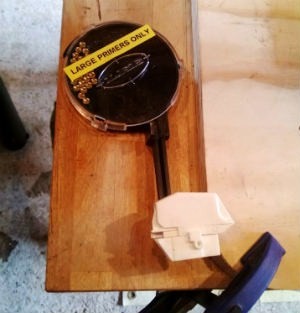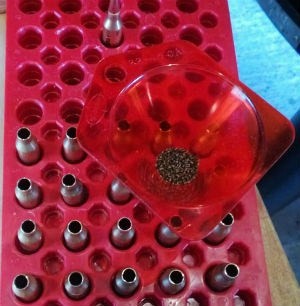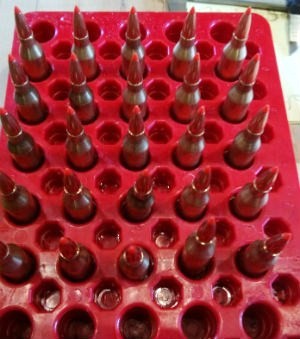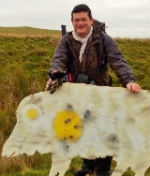In the second of two articles devoted to reloading, having cleaned up brass filings and spent primers, Dr Simon Lee looks at bullet and powder selection.

Ask any stalker what ammunition they prefer and you'll waste what otherwise might have been a productive hour, conversely, ask any deer and they won't care. Instant death should be the objective when I pull the trigger, or should I say, gently squeeze.
(If you would like to first read Part I of 'A Bumblers Guide to Reloading' follow this link:a-bumblers-guide-to-reloading-part-i)
I opted for Vitavhori N150 as it could be used for both .243 and .308. I wasn't after some Olympic benchrest exotic preparation, just a powder that would spit the bullet out consistently, also it was on special offer, needless to say, other powders are available.
Next, bullets, I chose 105gr Hornady Amax in .243 and 150gr Amax in .308 as they were readily available and good value.
An interesting note here, the Amax bullet is classified as a match round, i.e. target and as such doesn't have to be entered onto your FAC, other ballistic tips and soft points are classed as expanding ammunition and have to be logged on your certificate.
On the subject of legality and staying out of trouble, should you have an allowance of, say, 500 rounds of a given calibre, it's only when you put all the components together to make a round that it counts, separate components can be kept until required, if you have a visit and have exceeded the allowance you will find yourself explaining why.
Priming
 At this stage we focus on safety, primers are the initiator of the contained explosion that fires out the bullet and must be treated with respect, when priming cases safety glasses should be worn, the potential for injury from flying bits of uncontained primer has to be managed, however unlikely.
At this stage we focus on safety, primers are the initiator of the contained explosion that fires out the bullet and must be treated with respect, when priming cases safety glasses should be worn, the potential for injury from flying bits of uncontained primer has to be managed, however unlikely.
In it's simplest form the small shiny pill has to be pressed into the primer pocket, I opted for an auto primer as handling small shiny objects usually results in them all over the floor.
From their individual sections of the packet the primers are tipped into the tray, when shaken lightly the primers magically right themselves on the stippled surface and are sealed flat with the lid.
If done manually each primer needs to be placed the right way up into the primer arm, as the downstroke of the lever pulls the fitted case down it gently seats the primer at the correct depth, i.e. not sticking out of the bottom of the case.
Whichever way you choose, each case has to be checked to ensure the primer sits flush with, or slightly recessed into the case, a primer standing proud offers the chance to go off unexpectedly, so check each one!
Powder & Measuring
 In a nutshell, accuracy is everything, on the instructions on the dies each powder and bullet combination states a starting load and a maximum load as well as a ‘never exceed number in grains’.
In a nutshell, accuracy is everything, on the instructions on the dies each powder and bullet combination states a starting load and a maximum load as well as a ‘never exceed number in grains’.
A note here, a grain is 0.0647989grams and a gram is 15.43236grains respectively, don't for God sake confuse them!
In the die set is a little barrel measure, this got put away immediately after the first wildly inaccurate attempts put powder all over my clean bench surfaces. More precise methods are the balance beam scales, but these didn't suit me as I had dozens of cases to load. Included in my starter kit was the perfect powder measure, a hopper fed system that measures the charge volumetrically with an adjuster on the side. After some initial twiddling and more spilled powder, this time onto a tray, lesson learned, I had a delivery system that dispensed the 2.85grams I was looking for each time.
Not trusting this everytime, I measure each charge onto a digital scale from the internet, accurate to 1/100th of a gram, cost me £12, others are available.
Occasionally the measure would dispense a charge load of 2.9 or 2.73 and they got tipped back into the hopper as I was after consistency every time.
Once a correct load of 2.85grams has been dispensed, it gets tipped into a case via a small funnel, this proves an exercise in mental order and repetition, it took about twenty cases before my attention span failed and I double filled a case, not the end of the world as with a .308 the powder spills over but with smaller calibres a double load can ruin your whole day and possibly more after. Check every fill and use the reloading trays for consistency.
Measure, check, fill, move case, shift funnel, it sounds tedious but is actually strangely therapeutic, before long the 100 cases on the tray were filled and checked. I like to seat the bullets immediately after filling, leaving powder exposed for any time invites humidity and doubt into the process.
Seating the bullet
 The third die in my turret is the seating die, here I made up a dummy round, under instruction, and slid a case with bullet tip into the breach of my rifle and gently closed the bolt. This had the effect of placing the bullet into the case to give a case overall length, the maximum of which on a .308 with these Lee dies is 2.81" or 71.37mm to the metric among us.
The third die in my turret is the seating die, here I made up a dummy round, under instruction, and slid a case with bullet tip into the breach of my rifle and gently closed the bolt. This had the effect of placing the bullet into the case to give a case overall length, the maximum of which on a .308 with these Lee dies is 2.81" or 71.37mm to the metric among us.
This results in a round that is the correct Case Overall Length (COAL) for your rifle, instructions for this are best thoroughly read beforehand.
In goes the case, as you support the bullet tip the die swallows both and seats the bullet at the correct depth. Don't trust it? Fair enough. Compare it against the dummy round with the vernier guage for peace of mind. Too far in? Out with the hammer style bullet puller and start again. Too far out? Adjust the seating die and get it right.
Crimping the Case Neck.
This seals the case around the bullet to avoid dislodging it. This last stage finished the reloading process apart from a labeling of the batch with date, charge, powder used and bullet weight.
 (Left: Simon Lee)
(Left: Simon Lee)
To read Part I of the Bumblers Guide to Reloading follow this link: a-bumblers-guide-to-reloading-part-i



















